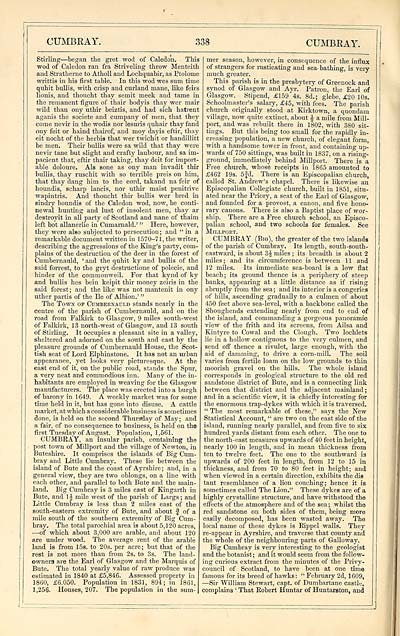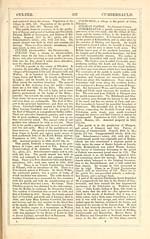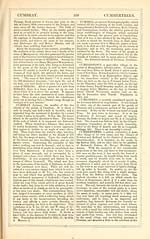Download files
Complete book:
Individual page:
Thumbnail gallery: Grid view | List view

CUMBRAY.
338
CUMBRAY.
Stirling — began the gret wod of Caledon. This
wod of Caledon ran fra Striveling throw Menteith
and Stratherne to Atholl and Lochquabir, as Ptolome
writtis in his first table. In this wod wes sum time
quhit bullis, with crisp and eurland mane, like feirs
lionis, and thoucht thay semit meek and tame in
the remanent figure of thair bodyis thay wer mair
wild than ony uthir beiztis, and had sieh hatrent
aganis the societe and cumpany of men, that they
come nevir in the wodis nor lesuris quhair thay fand
ony feit or haind thairof, and moy dayis eftir, thay
eit nooht of the herbis that wer twichit or handillitt
be men. Their bullis were sa wild that thay were
nevir tane but slight and crafty laubour, and sa im-
patient that, eftir thair taking, thay deit for import-
able doloure. Als sone as ony man invadit thir
bullis, thay ruschit with so terrible preis on him,
that thay dang him to the eord, takand na feir of
houndis, scharp lancis, nor uthir maist penitrive
wapintris. And thoucht thir bullis wer bred in
sindry boundis of the Caledon wod, now, be conti-
newal hunting and lust of insolent men, thay ar
destroyit in all party of Scotland and nane of thaim
left bot allanerlie in Cumamald.' " Here, however,
they were also subjected to persecution; and " in a
remarkable document written in 1570-71, the writer,
describing the aggressions of the King's party, com-
plains of the destruction of the deer in the forest of
Cumbernauld, ' and the quhit ky and bullis of the
said forrest, to the gryt destructione of polecie, and
hinder of the commonweil. For that kynd of ky
and bullis hes bein keipit thir money zeiris in the
said forest ; and the like was not mantenit in ony
uther partis of the He of Albion.' "
The Town of Cumbernauld stands nearly in the
centre of the parish of Cumbernauld, and on the
road from Falkirk to Glasgow, 9 miles south-west
of Falkirk, 13 north-west of Glasgow, and 13 south
of Stirling. It occupies a pleasant site in a valley,
sheltered and adorned on the south and east by the
pleasure grounds of Cumbernauld House, the Scot-
tish seat of Lord Elphinstone. It has not an urban
appearance, yet looks very picturesque. At the
east end of it, on the public road, stands the Spur,
a very neat and commodious inn. Many of the in-
habitants are employed in weaving for the Glasgow
manufacturers. The place was erected into a burgh
of barony in 1649. A weekly market was for some
time held in it, but has gone into disuse. A cattle
market, at which a considerable business is sometimes
done, is held on the second Thursday of May; and
a fair, of no consequence to business, is held on the
first Tuesday of August. Population, 1,561.
CUMBRAY, an insular parish, containing the
post town of Millport and the village of Newton, in
Buteshire. It comprises the islands of Big Cnm-
bray and Little Cumbray. These lie between the
island of Bute and the coast of Ayrshire ; and, in a
general view, they are two oblongs, on a line with
each other, and parallel to both Bute and the main-
land. Big Cumbray is 3 miles east of Kingarth in
Bute, and 1J mile west of the parish of Largs; and
Little Cumbray is less than 2 miles east of the
south-eastern extremity of Bute, and about § of a
mile south of the southern extremity of Big Cum-
bray. The total parochial area is about 5,120 acres,
— of which about 3,000 are arable, and about 120
are under wood. The average rent of the arable
land is from 15s. to 20s. per acre; but that of the
rest i3 not more than from 2s. to 3s. The land-
owners are the Earl of Glasgow and the Marquis of
Bute. The total yearly value of raw produce was
estimated in 1840 at £5,846. Assessed property in
1860, £6,050. Population in 1831, 894; in 1861,
1,256. Houses, 207. The population in the sum-
mer season, however, in consequence of the influx
of strangers for rusticating and sea-bathing, is very
much greater.
This parish is in the presbytery of Greenock and
synod of Glasgow and Ayr. Patron, the Earl of
Glasgow. Stipend, £159 4s. 8d.; glebe, £20 10s.
Schoolmaster's salary, £45, with fees. The parish
church originally stood at Kirktown, a quondam
village, now quite extinct, about J a mile from Mill-
port, and was rebuilt there in 1802, with 380 sit-
tings. But this being too small for the rapidly in-
creasing population, a new church, of elegant form,
with a handsome tower in front, and containing up-
wards of 750 sittings, was built in 1837, on a rising-
ground, immediately behind Millport. There is a
Free church, whose receipts in 1865 amounted to
£462 19s. 5fd. There is an Episcopalian church,
called St. Andrew's chapel. There is likewise an
Episcopalian Collegiate church, built in 1851, situ-
ated near the Priory, a seat of the Earl of Glasgow,
and founded for a provost, a canon, and five hono-
rary canons. There is also a Baptist place of wor-
ship. There are a Free church school, an Episco-
palian school, and two schools for females. See
Millport.
CUMBRAY (Big), the greater of the two islands
of the parish of Cumbray. Its length, south-south-
eastward, is about 3i miles ; its breadth is about 2
miles; and its circumference is between 11 and
12 miles. Its immediate sea-board is a low fiat
beach; its ground thence is a periphery of steep
banks, appearing at a little distance as if rising
abruptly from the sea; and its interior is a congeries
of hills, ascending gradually to a culmen of about
450 feet above sea-level, with a backbone called the
Shoughends extending nearly from end to end of
the island, and commanding a gorgeous panoramic
view of the frith and its screens, from Ailsa and
Kintyre to Cowal and the Clough. Two lochlets
lie in a hollow contiguous to the very culmen, and
send off thence a rivulet, large enough, with the
aid of damming, to drive a corn-mill. The soil
varies from fertile loam on the low grounds to thin
moorish gravel on the hills. The whole island
corresponds in geological structure to the old red
sandstone district of Bute, and is a connecting link
between that district and the adjacent mainland;
and in a scientific view, it is chiefly interesting for
the enormous trap-dykes with which it is traversed.
" The most remarkable of these," says the New
Statistical Account, " are two on the east side of the
island, running nearly parallel, and from five to six
hundred yards distant from each other. The one to
the north-east measures upwards of 40 feet in height,
nearly 100 in length, and in mean thickness from
ten to twelve feet. The one to the southward is
upwards of 200 feet in length, from 12 to 15 in
thickness, and from 70 to 80 feet in height; and
when viewed in a certain direction, exhibits the dis
tant resemblance of a lion couching; hence it is
sometimes called The Lion." These dykes are of a
highly crystalline structure, and have withstood the
effects of the atmosphere and of the sea ; whilst the
red sandstone on both sides of them, being more
easily decomposed, has been wasted away. The
local name of these dykes is Rippel walls. They
re-appear in Ayrshire, and traverse that county and
the whole of the neighbouring parts of Galloway.
Big Cumbray is very interesting to the geologist
and the botanist ; and it would seem from the follow-
ing curious extract from the minutes of the Privy-
council of Scotland, to have been at one time
famous for its breed of hawks: " February 2d, 1609,
— Sir William Stewart, capt. of Dumbartane castle,
complains ' That Robert Huntar of Huntarston, and
338
CUMBRAY.
Stirling — began the gret wod of Caledon. This
wod of Caledon ran fra Striveling throw Menteith
and Stratherne to Atholl and Lochquabir, as Ptolome
writtis in his first table. In this wod wes sum time
quhit bullis, with crisp and eurland mane, like feirs
lionis, and thoucht thay semit meek and tame in
the remanent figure of thair bodyis thay wer mair
wild than ony uthir beiztis, and had sieh hatrent
aganis the societe and cumpany of men, that they
come nevir in the wodis nor lesuris quhair thay fand
ony feit or haind thairof, and moy dayis eftir, thay
eit nooht of the herbis that wer twichit or handillitt
be men. Their bullis were sa wild that thay were
nevir tane but slight and crafty laubour, and sa im-
patient that, eftir thair taking, thay deit for import-
able doloure. Als sone as ony man invadit thir
bullis, thay ruschit with so terrible preis on him,
that thay dang him to the eord, takand na feir of
houndis, scharp lancis, nor uthir maist penitrive
wapintris. And thoucht thir bullis wer bred in
sindry boundis of the Caledon wod, now, be conti-
newal hunting and lust of insolent men, thay ar
destroyit in all party of Scotland and nane of thaim
left bot allanerlie in Cumamald.' " Here, however,
they were also subjected to persecution; and " in a
remarkable document written in 1570-71, the writer,
describing the aggressions of the King's party, com-
plains of the destruction of the deer in the forest of
Cumbernauld, ' and the quhit ky and bullis of the
said forrest, to the gryt destructione of polecie, and
hinder of the commonweil. For that kynd of ky
and bullis hes bein keipit thir money zeiris in the
said forest ; and the like was not mantenit in ony
uther partis of the He of Albion.' "
The Town of Cumbernauld stands nearly in the
centre of the parish of Cumbernauld, and on the
road from Falkirk to Glasgow, 9 miles south-west
of Falkirk, 13 north-west of Glasgow, and 13 south
of Stirling. It occupies a pleasant site in a valley,
sheltered and adorned on the south and east by the
pleasure grounds of Cumbernauld House, the Scot-
tish seat of Lord Elphinstone. It has not an urban
appearance, yet looks very picturesque. At the
east end of it, on the public road, stands the Spur,
a very neat and commodious inn. Many of the in-
habitants are employed in weaving for the Glasgow
manufacturers. The place was erected into a burgh
of barony in 1649. A weekly market was for some
time held in it, but has gone into disuse. A cattle
market, at which a considerable business is sometimes
done, is held on the second Thursday of May; and
a fair, of no consequence to business, is held on the
first Tuesday of August. Population, 1,561.
CUMBRAY, an insular parish, containing the
post town of Millport and the village of Newton, in
Buteshire. It comprises the islands of Big Cnm-
bray and Little Cumbray. These lie between the
island of Bute and the coast of Ayrshire ; and, in a
general view, they are two oblongs, on a line with
each other, and parallel to both Bute and the main-
land. Big Cumbray is 3 miles east of Kingarth in
Bute, and 1J mile west of the parish of Largs; and
Little Cumbray is less than 2 miles east of the
south-eastern extremity of Bute, and about § of a
mile south of the southern extremity of Big Cum-
bray. The total parochial area is about 5,120 acres,
— of which about 3,000 are arable, and about 120
are under wood. The average rent of the arable
land is from 15s. to 20s. per acre; but that of the
rest i3 not more than from 2s. to 3s. The land-
owners are the Earl of Glasgow and the Marquis of
Bute. The total yearly value of raw produce was
estimated in 1840 at £5,846. Assessed property in
1860, £6,050. Population in 1831, 894; in 1861,
1,256. Houses, 207. The population in the sum-
mer season, however, in consequence of the influx
of strangers for rusticating and sea-bathing, is very
much greater.
This parish is in the presbytery of Greenock and
synod of Glasgow and Ayr. Patron, the Earl of
Glasgow. Stipend, £159 4s. 8d.; glebe, £20 10s.
Schoolmaster's salary, £45, with fees. The parish
church originally stood at Kirktown, a quondam
village, now quite extinct, about J a mile from Mill-
port, and was rebuilt there in 1802, with 380 sit-
tings. But this being too small for the rapidly in-
creasing population, a new church, of elegant form,
with a handsome tower in front, and containing up-
wards of 750 sittings, was built in 1837, on a rising-
ground, immediately behind Millport. There is a
Free church, whose receipts in 1865 amounted to
£462 19s. 5fd. There is an Episcopalian church,
called St. Andrew's chapel. There is likewise an
Episcopalian Collegiate church, built in 1851, situ-
ated near the Priory, a seat of the Earl of Glasgow,
and founded for a provost, a canon, and five hono-
rary canons. There is also a Baptist place of wor-
ship. There are a Free church school, an Episco-
palian school, and two schools for females. See
Millport.
CUMBRAY (Big), the greater of the two islands
of the parish of Cumbray. Its length, south-south-
eastward, is about 3i miles ; its breadth is about 2
miles; and its circumference is between 11 and
12 miles. Its immediate sea-board is a low fiat
beach; its ground thence is a periphery of steep
banks, appearing at a little distance as if rising
abruptly from the sea; and its interior is a congeries
of hills, ascending gradually to a culmen of about
450 feet above sea-level, with a backbone called the
Shoughends extending nearly from end to end of
the island, and commanding a gorgeous panoramic
view of the frith and its screens, from Ailsa and
Kintyre to Cowal and the Clough. Two lochlets
lie in a hollow contiguous to the very culmen, and
send off thence a rivulet, large enough, with the
aid of damming, to drive a corn-mill. The soil
varies from fertile loam on the low grounds to thin
moorish gravel on the hills. The whole island
corresponds in geological structure to the old red
sandstone district of Bute, and is a connecting link
between that district and the adjacent mainland;
and in a scientific view, it is chiefly interesting for
the enormous trap-dykes with which it is traversed.
" The most remarkable of these," says the New
Statistical Account, " are two on the east side of the
island, running nearly parallel, and from five to six
hundred yards distant from each other. The one to
the north-east measures upwards of 40 feet in height,
nearly 100 in length, and in mean thickness from
ten to twelve feet. The one to the southward is
upwards of 200 feet in length, from 12 to 15 in
thickness, and from 70 to 80 feet in height; and
when viewed in a certain direction, exhibits the dis
tant resemblance of a lion couching; hence it is
sometimes called The Lion." These dykes are of a
highly crystalline structure, and have withstood the
effects of the atmosphere and of the sea ; whilst the
red sandstone on both sides of them, being more
easily decomposed, has been wasted away. The
local name of these dykes is Rippel walls. They
re-appear in Ayrshire, and traverse that county and
the whole of the neighbouring parts of Galloway.
Big Cumbray is very interesting to the geologist
and the botanist ; and it would seem from the follow-
ing curious extract from the minutes of the Privy-
council of Scotland, to have been at one time
famous for its breed of hawks: " February 2d, 1609,
— Sir William Stewart, capt. of Dumbartane castle,
complains ' That Robert Huntar of Huntarston, and
Set display mode to: Large image | Transcription
Images and transcriptions on this page, including medium image downloads, may be used under the Creative Commons Attribution 4.0 International Licence unless otherwise stated. ![]()
| Gazetteers of Scotland, 1803-1901 > Imperial gazeteer of Scotland, or, Dictionary of Scottish topography > Volume 1 > (448) Page 338 |
|---|
| Permanent URL | https://digital.nls.uk/97464506 |
|---|
| Description | Volume I: Aan-Gordon. |
|---|---|
| Attribution and copyright: |
|

